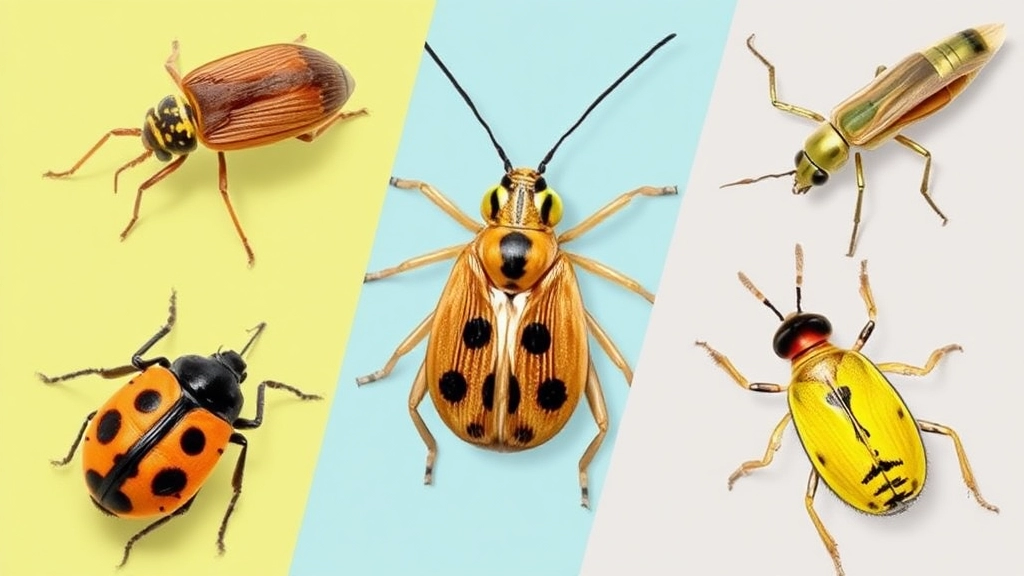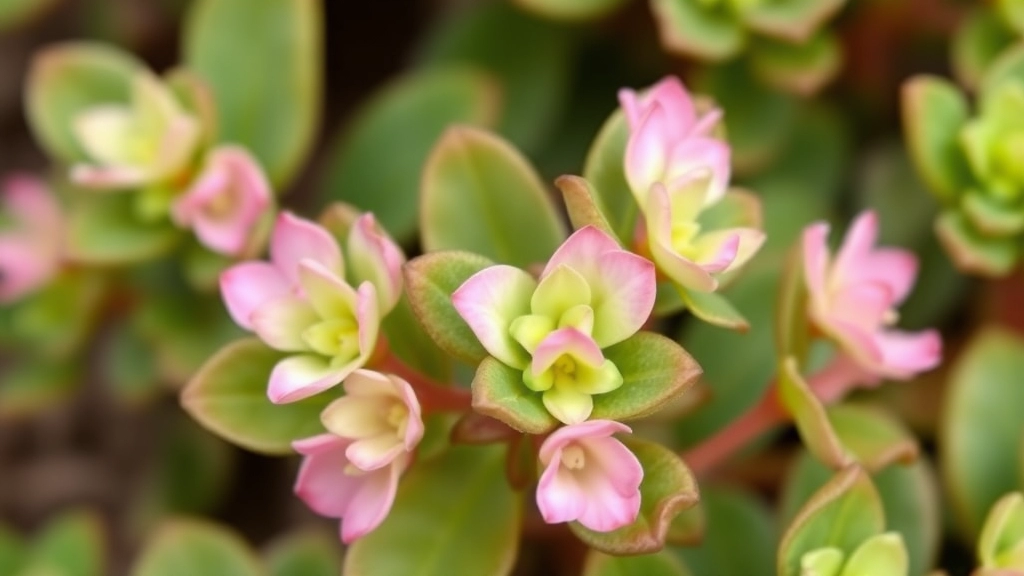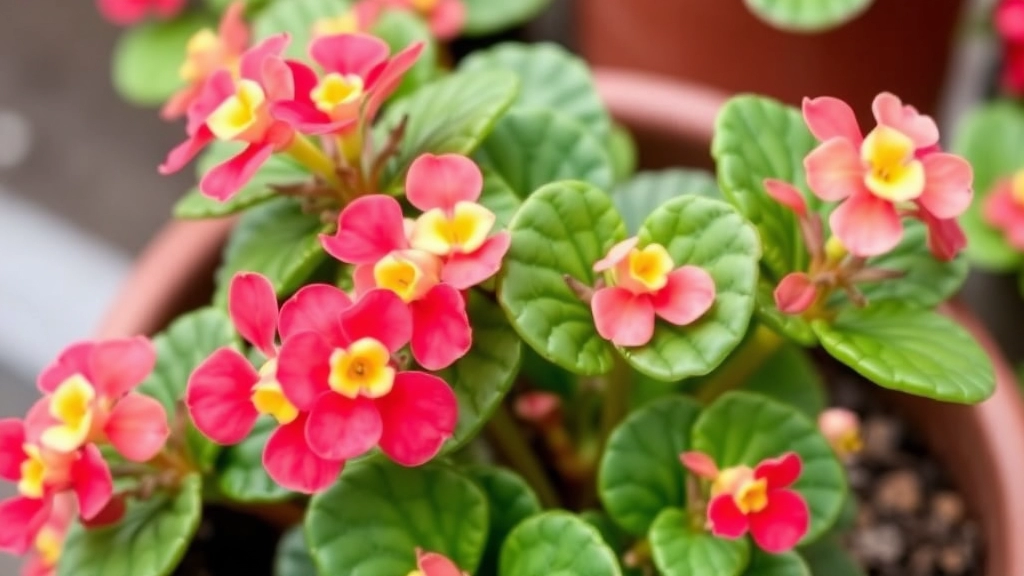Kalanchoe Daigremontiana: The Mexican Hat Plant
When it comes to unique succulents, the Kalanchoe Daigremontiana, also known as the Mexican Hat Plant, stands out with its intriguing features. This plant is famous for producing small plantlets along its leaves, making it a fascinating addition to any indoor garden. If you’re curious about how to care for, propagate, and manage this prolific grower, you’re in the right place.
Caring for Your Kalanchoe Daigremontiana
To ensure your Kalanchoe Daigremontiana thrives, it’s essential to understand its light and temperature preferences, watering needs, and ideal soil types. This plant not only adds a touch of the exotic to your home but also requires specific care to prevent issues like overcrowding and root rot. Additionally, being aware of its toxicity to pets and children is crucial for maintaining a safe environment. Let’s dive into the essentials of growing and maintaining this captivating succulent.
Key Characteristics of Kalanchoe Daigremontiana
When considering houseplants that are both striking and easy to care for, Kalanchoe Daigremontiana often comes to mind.
This unique succulent, also known as the “Mother of Thousands,” is famous for its distinctive features.
- Leaf Structure: The leaves are thick, fleshy, and can grow up to 30 cm long. They are dark green with a wavy edge, giving them a captivating appearance.
- Plantlets: One of the most remarkable characteristics is its ability to produce numerous small plantlets along the edges of its leaves. These tiny plants can easily root themselves in soil, making propagation a breeze.
- Growth Habit: Kalanchoe Daigremontiana typically grows upright, reaching heights of up to 1 meter. Its bushy form adds a lush touch to any indoor space.
- Flowering: This succulent produces small, tubular flowers that can range in colour from pink to orange. While not the primary attraction, they add a delightful pop of colour during the blooming season.
- Toxicity: It’s important to note that Kalanchoe Daigremontiana is toxic to pets, so care should be taken if you have furry friends at home.
Understanding these key characteristics is essential for providing the right care and ensuring your plant thrives.
For more detailed information on this fascinating plant, check out our complete guide to growing Kalanchoe Mother of Thousands. Additionally, if you’re interested in exploring other varieties, our top Kalanchoe Mother of Thousands varieties and care tips might be helpful.
Ideal Light and Temperature Conditions

Are you struggling to keep your Kalanchoe Daigremontiana thriving? One of the biggest factors to consider is light and temperature.
Light Requirements
Kalanchoe Daigremontiana loves bright, indirect sunlight.
- Best Spot: A south or west-facing window is ideal.
- Avoid Direct Sun: Too much direct sunlight can scorch those beautiful leaves.
- Supplemental Lighting: If natural light is limited, consider using grow lights to give your plant that extra boost.
Temperature Preferences
Temperature is just as crucial. Kalanchoe Daigremontiana thrives in warm conditions.
- Ideal Range: Aim for a temperature between 20°C to 25°C (68°F to 77°F).
- Cold Sensitivity: Keep it away from drafts or areas with temperatures below 10°C (50°F).
- Humidity Levels: This plant isn’t too picky about humidity, but a drier environment is generally better.
Watering Guidelines for Optimal Growth
When cultivating Kalanchoe Daigremontiana, understanding the watering needs is crucial for its health and vitality. Many plant enthusiasts often worry about how much water their succulents require.
Key Watering Principles
- Soil Moisture:
- Ensure the top inch of soil dries out completely before watering again.
- This prevents root rot, a common issue with overwatering.
- Watering Frequency:
- During the growing season (spring and summer), water every 2-3 weeks.
- In the dormant season (autumn and winter), reduce watering to once a month.
- Watering Technique:
- Use the “soak and dry” method.
- Water thoroughly until it drains from the bottom, then allow the pot to dry out completely.
Signs of Overwatering
- Yellowing leaves
- Mushy stems
- A foul smell from the soil
Conversely, underwatering can also be detrimental. Look for signs like shrivelling leaves or a droopy appearance.
Best Soil Types for Kalanchoe Daigremontiana

Choosing the right soil for Kalanchoe Daigremontiana is crucial for its health and growth. If you’ve ever struggled with soil selection, you’re not alone. Many plant enthusiasts find themselves overwhelmed by the options available.
Soil Composition
Kalanchoe Daigremontiana thrives in well-draining soil. Here are the key components to consider:
- Cactus Mix: A pre-mixed cactus soil is often ideal, as it provides excellent drainage.
- Perlite or Pumice: Adding these materials improves aeration and drainage.
- Organic Matter: A small amount of compost can provide nutrients without retaining too much moisture.
pH Levels
Aim for a slightly acidic to neutral pH level, around 6.0 to 7.0. This range supports optimal nutrient uptake.
Custom Soil Mix
If you’re feeling adventurous, you can create your own soil mix. Here’s a simple recipe:
- 50% cactus mix
- 25% perlite
- 25% potting soil
This blend ensures your Kalanchoe has the right balance of drainage and nutrients.
Pot Selection
Don’t forget about the pot! Choose one with drainage holes to prevent water from accumulating at the bottom. Terracotta pots are a great choice as they allow moisture to evaporate.
As we delve into the exciting world of Kalanchoe Daigremontiana propagation, it’s essential to understand how to cultivate new plants effectively from the mother plant. Many enthusiasts often wonder how to expand their collection without breaking the bank or relying on stores.
Kalanchoe Daigremontiana is renowned for its ease of propagation. Here are the most effective methods:
– **Leaf Cuttings:**
– Select a healthy leaf from the mother plant.
– Allow it to dry for a day or two to form a callous.
– Place it on well-draining soil, ensuring the cut end touches the soil.
– Water sparingly until roots develop.
– **Plantlets:**
– This species produces small plantlets along the edges of its leaves.
– Gently remove these plantlets once they are a few inches tall.
– Plant them in individual pots with suitable soil.
– **Offsets:**
– If your Kalanchoe has grown larger, it may produce offsets at the base.
– Carefully separate these offsets and pot them separately.
Once you have propagated your Kalanchoe Daigremontiana, managing the new plantlets is crucial for their success. Here are some key tips:
– **Light:**
– Ensure they receive bright, indirect sunlight.
– **Watering:**
– Water sparingly, allowing the soil to dry out between waterings.
– **Soil:**
– Use a well-draining potting mix to prevent root rot.
– **Temperature:**
– Keep them in a warm environment, ideally between 20-25°C.
For more detailed guidance on caring for propagated Kalanchoe, you might find our [complete guide to Kalanchoe Mother of Thousands care and propagation](https://planthq.org/complete-guide-to-kalanchoe-mother-of-thousands-care-propagation/) very useful. Additionally, if you’re interested in exploring other propagation techniques, check out our [step-by-step guide on how to propagate Kalanchoe leaves](https://planthq.org/how-to-propagate-kalanchoe-leaves-a-stepbystep-guide/).
Common Pests and Diseases to Watch Out For

So, you’ve got your Kalanchoe Daigremontiana thriving, and you’re feeling pretty proud. But wait—what if those pesky pests or sneaky diseases come knocking? It’s crucial to keep an eye out for these troublemakers to ensure your plant stays healthy and vibrant.
Common Pests
- Mealybugs
- These little white fluff balls love to hide in the leaf joints.
- They suck the sap, weakening your plant.
- Aphids
- Tiny and green, they can multiply quickly.
- They also sap nutrients, leading to stunted growth.
- Spider Mites
- Look for tiny webs on your plant.
- They thrive in dry conditions and can cause leaf drop.
- Scale Insects
- Small, brown bumps on leaves indicate scale.
- They, too, suck sap and can lead to leaf yellowing.
Common Diseases
- Root Rot
- Overwatering is the main culprit.
- Yellowing leaves and a mushy stem are telltale signs.
- Powdery Mildew
- A white, powdery substance on leaves.
- Usually caused by high humidity and poor air circulation.
- Leaf Spot
- Dark spots on leaves can signal fungal infections.
- Often linked to overwatering or poor drainage.
Prevention Tips
- Regular Inspection: Check your plant weekly for any signs of pests or diseases.
- Proper Watering: Avoid overwatering to keep root rot at bay.
- Good Airflow: Ensure your plant has enough space to breathe, preventing mildew.
Tips for Preventing Overcrowding and Root Rot
As we delve deeper into the care of Kalanchoe Daigremontiana, it’s essential to address the common issues of overcrowding and root rot. These problems can significantly hinder the plant’s growth and overall health, leading to frustration for any plant enthusiast.
Understanding Overcrowding
Overcrowding occurs when multiple plants are placed too closely together, competing for space, light, and nutrients. This can stunt growth and increase the risk of diseases. Here are some practical tips to prevent overcrowding:
- Choose the Right Pot Size: Ensure that your pot is adequately sized for your Kalanchoe. A pot that is too small can lead to overcrowding, while one that is too large may retain excess moisture.
- Regular Pruning: Trim back any leggy growth to maintain shape and ensure that each plant has enough space to thrive. This also encourages bushier growth.
- Spacing: If you have multiple Kalanchoe plants, maintain a distance of at least a few inches apart to allow for air circulation.
Preventing Root Rot
Root rot is a common issue caused by overwatering or poor drainage. Here’s how to keep your Kalanchoe healthy:
- Water Wisely: Allow the soil to dry out between waterings. Kalanchoe prefers dry conditions, so it’s better to underwater than overwater.
- Drainage Holes: Ensure your pot has sufficient drainage holes to allow excess water to escape. This is crucial for preventing waterlogged soil.
- Use Well-Draining Soil: Opt for a soil mix specifically designed for succulents or cacti, which promotes drainage and prevents moisture retention.
- Monitor Humidity: Keep your plant in a location with moderate humidity. High humidity can contribute to root rot, so aim for a well-ventilated area.
By implementing these strategies, you can create a thriving environment for your Kalanchoe Daigremontiana, ensuring it flourishes without the risk of overcrowding or root rot. For more detailed care instructions, check out our Kalanchoe Mother of Thousands care guide and learn how to propagate Kalanchoe from leaves successfully.
Understanding the Toxicity of Kalanchoe Daigremontiana

When it comes to keeping Kalanchoe Daigremontiana, many of us might wonder: is this plant safe for my home, especially if I have pets or kids around?
Toxicity Overview
Kalanchoe Daigremontiana, often called Mother of Thousands, is indeed a beautiful succulent. But here’s the scoop: it’s toxic to pets and humans if ingested.
- Symptoms of Toxicity:
- Vomiting
- Diarrhoea
- Lethargy
- In severe cases, it can lead to more serious health issues.
What Makes It Toxic?
The plant contains compounds called bufadienolides, which can disrupt heart function in both pets and humans.
Safety Tips
If you’re thinking about adding this striking plant to your collection, here are some quick safety tips:
- Placement: Keep it out of reach of children and pets.
- Education: Teach kids not to touch or eat any part of the plant.
- Monitoring: Keep an eye on your pets when they’re around your plants.
Seasonal Maintenance and Repotting Strategies
As we delve into the seasonal maintenance and repotting strategies for Kalanchoe Daigremontiana, it’s essential to consider how these practices can significantly influence the plant’s health and growth.
Understanding Seasonal Changes
Kalanchoe Daigremontiana thrives with a clear understanding of its seasonal needs. Each season brings unique requirements for care, ensuring the plant remains vibrant and healthy.
Spring: Time for Growth and Repotting
- Repotting: Spring is the ideal time to repot your Kalanchoe.
- Choose a pot that is one size larger.
- Ensure it has drainage holes to prevent water retention.
- Soil Refresh: Use fresh, well-draining soil to provide nutrients. For more detailed soil requirements, check out our Kalanchoe Mother of Thousands Care Guide.
- Fertilisation: Start feeding your plant with a balanced fertiliser every four to six weeks.
Summer: Maintenance and Monitoring
- Watering: Increase watering frequency as temperatures rise, but ensure the soil dries out between waterings.
- Light Adjustment: Ensure your plant receives plenty of indirect sunlight to prevent leaf scorch.
Autumn: Preparing for Dormancy
- Water Reduction: Gradually reduce watering as the days shorten.
- Temperature Check: Maintain a stable environment, avoiding cold drafts that can stress the plant.
Winter: Care and Caution
- Minimal Watering: Water sparingly, as Kalanchoe enters dormancy.
- Light Exposure: Provide as much light as possible. Consider using grow lights if natural light is insufficient.
Repotting Tips to Keep in Mind
- Signs It’s Time to Repot:
- Roots emerging from drainage holes.
- Soil dries out too quickly.
- Steps for Successful Repotting:
- Gently remove the plant from its pot.
- Trim any damaged roots before placing it in the new pot.
- Fill with fresh soil, ensuring the plant is at the same depth as before.
For more expert tips on repotting and general care, visit our How to Grow and Care for Kalanchoe Mother of Thousands guide.
FAQs About Kalanchoe Daigremontiana (Mexican Hat Plant)
What are the ideal light conditions for Kalanchoe Daigremontiana?
Kalanchoe Daigremontiana thrives in bright, indirect sunlight. A south or west-facing window is ideal, but avoid too much direct sunlight to prevent leaf scorching. If natural light is limited, consider using grow lights.
What temperature range is best for Kalanchoe Daigremontiana?
The ideal temperature range for Kalanchoe Daigremontiana is between 20°C to 25°C (68°F to 77°F). It should be kept away from drafts or areas with temperatures below 10°C (50°F).
What type of soil is best for Kalanchoe Daigremontiana?
Kalanchoe Daigremontiana prefers well-draining soil. A pre-mixed cactus soil is often ideal. Adding perlite or pumice can improve aeration and drainage, and a small amount of compost can provide necessary nutrients.
How can I create a custom soil mix for Kalanchoe Daigremontiana?
You can create a custom soil mix by combining 50% cactus mix, 25% perlite, and 25% potting soil. This blend ensures the right balance of drainage and nutrients.
What are common pests that affect Kalanchoe Daigremontiana?
Common pests include mealybugs, aphids, spider mites, and scale insects. Regular inspection and proper plant care can help manage these pests.
What are the signs of common diseases in Kalanchoe Daigremontiana?
Common diseases include root rot, powdery mildew, and leaf spot. Root rot is often caused by overwatering, while powdery mildew results from high humidity and poor air circulation. Leaf spot can be linked to overwatering or poor drainage.
Is Kalanchoe Daigremontiana toxic?
Yes, Kalanchoe Daigremontiana is toxic to pets and humans if ingested. It contains compounds called bufadienolides, which can disrupt heart function.
What are the symptoms of Kalanchoe Daigremontiana toxicity?
Symptoms of toxicity include vomiting, diarrhea, lethargy, and in severe cases, more serious health issues. Immediate medical attention is recommended if ingestion is suspected.
How can I keep my Kalanchoe Daigremontiana safe for pets and children?
To keep your plant safe for pets and children, place it out of their reach, educate kids not to touch or eat any part of the plant, and monitor pets when they are around your plants.
References
-
Growing Kalanchoe Daigremontiana (Mother of Thousands) – The Spruce
-
Kalanchoe Plant Care – Gardening Know How
-
Kalanchoe Daigremontiana (Mother of Thousands) Care Guide – House Plants Expert
